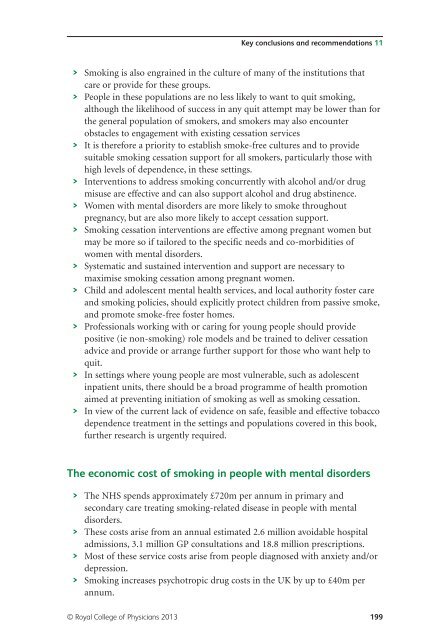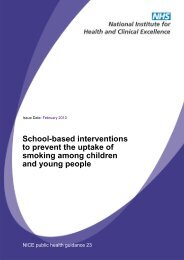Smoking and mental health - NCSCT
Smoking and mental health - NCSCT
Smoking and mental health - NCSCT
Create successful ePaper yourself
Turn your PDF publications into a flip-book with our unique Google optimized e-Paper software.
Key conclusions <strong>and</strong> recommendations 11<br />
> <strong>Smoking</strong> is also engrained in the culture of many of the institutions that<br />
care or provide for these groups.<br />
> People in these populations are no less likely to want to quit smoking,<br />
although the likelihood of success in any quit attempt may be lower than for<br />
the general population of smokers, <strong>and</strong> smokers may also encounter<br />
obstacles to engagement with existing cessation services<br />
> It is therefore a priority to establish smoke-free cultures <strong>and</strong> to provide<br />
suitable smoking cessation support for all smokers, particularly those with<br />
high levels of dependence, in these settings.<br />
> Interventions to address smoking concurrently with alcohol <strong>and</strong>/or drug<br />
misuse are effective <strong>and</strong> can also support alcohol <strong>and</strong> drug abstinence.<br />
> Women with <strong>mental</strong> disorders are more likely to smoke throughout<br />
pregnancy, but are also more likely to accept cessation support.<br />
> <strong>Smoking</strong> cessation interventions are effective among pregnant women but<br />
may be more so if tailored to the specific needs <strong>and</strong> co-morbidities of<br />
women with <strong>mental</strong> disorders.<br />
> Systematic <strong>and</strong> sustained intervention <strong>and</strong> support are necessary to<br />
maximise smoking cessation among pregnant women.<br />
> Child <strong>and</strong> adolescent <strong>mental</strong> <strong>health</strong> services, <strong>and</strong> local authority foster care<br />
<strong>and</strong> smoking policies, should explicitly protect children from passive smoke,<br />
<strong>and</strong> promote smoke-free foster homes.<br />
> Professionals working with or caring for young people should provide<br />
positive (ie non-smoking) role models <strong>and</strong> be trained to deliver cessation<br />
advice <strong>and</strong> provide or arrange further support for those who want help to<br />
quit.<br />
> In settings where young people are most vulnerable, such as adolescent<br />
inpatient units, there should be a broad programme of <strong>health</strong> promotion<br />
aimed at preventing initiation of smoking as well as smoking cessation.<br />
> In view of the current lack of evidence on safe, feasible <strong>and</strong> effective tobacco<br />
dependence treatment in the settings <strong>and</strong> populations covered in this book,<br />
further research is urgently required.<br />
The economic cost of smoking in people with <strong>mental</strong> disorders<br />
> The NHS spends approximately £720m per annum in primary <strong>and</strong><br />
secondary care treating smoking-related disease in people with <strong>mental</strong><br />
disorders.<br />
> These costs arise from an annual estimated 2.6 million avoidable hospital<br />
admissions, 3.1 million GP consultations <strong>and</strong> 18.8 million prescriptions.<br />
> Most of these service costs arise from people diagnosed with anxiety <strong>and</strong>/or<br />
depression.<br />
> <strong>Smoking</strong> increases psychotropic drug costs in the UK by up to £40m per<br />
annum.<br />
© Royal College of Physicians 2013 199














